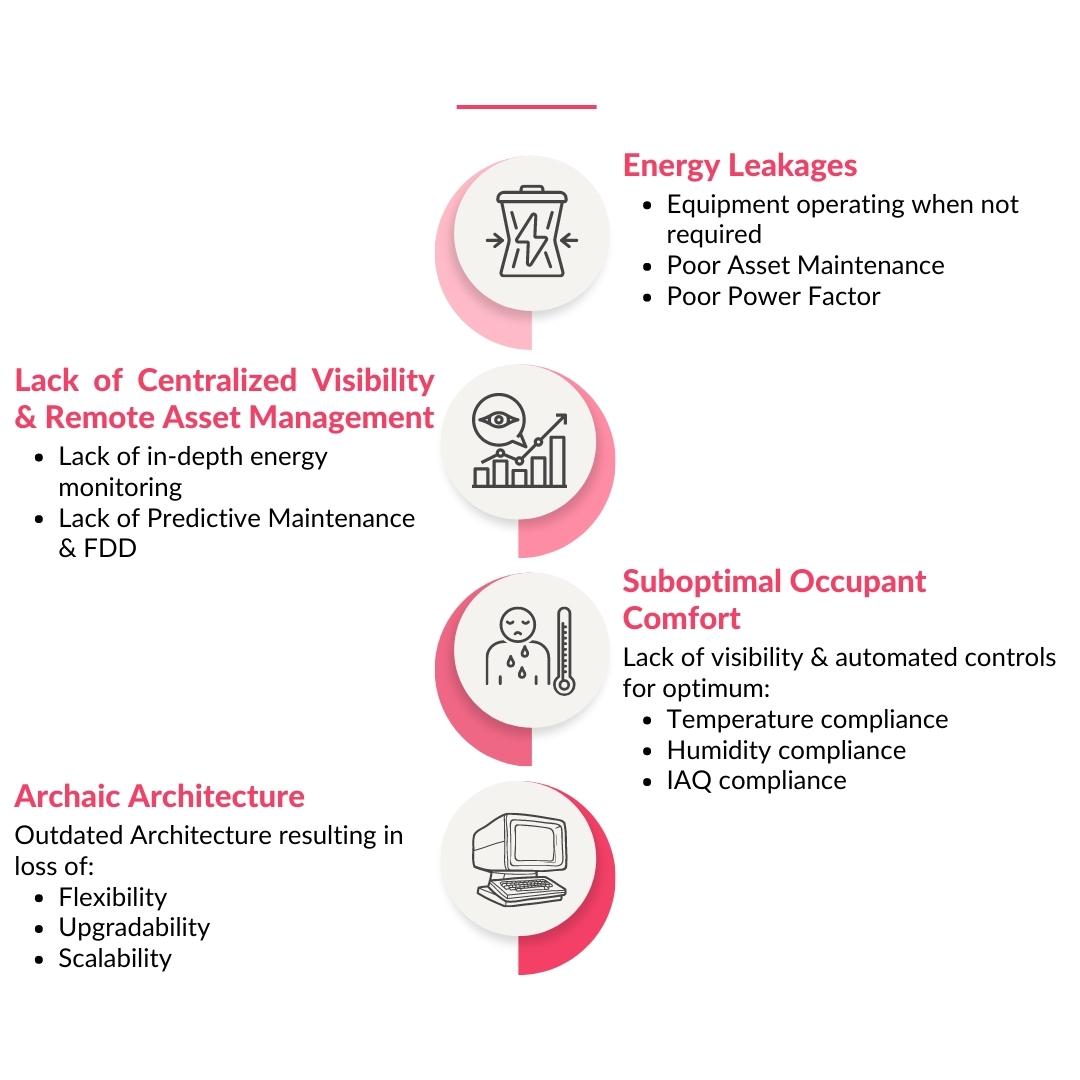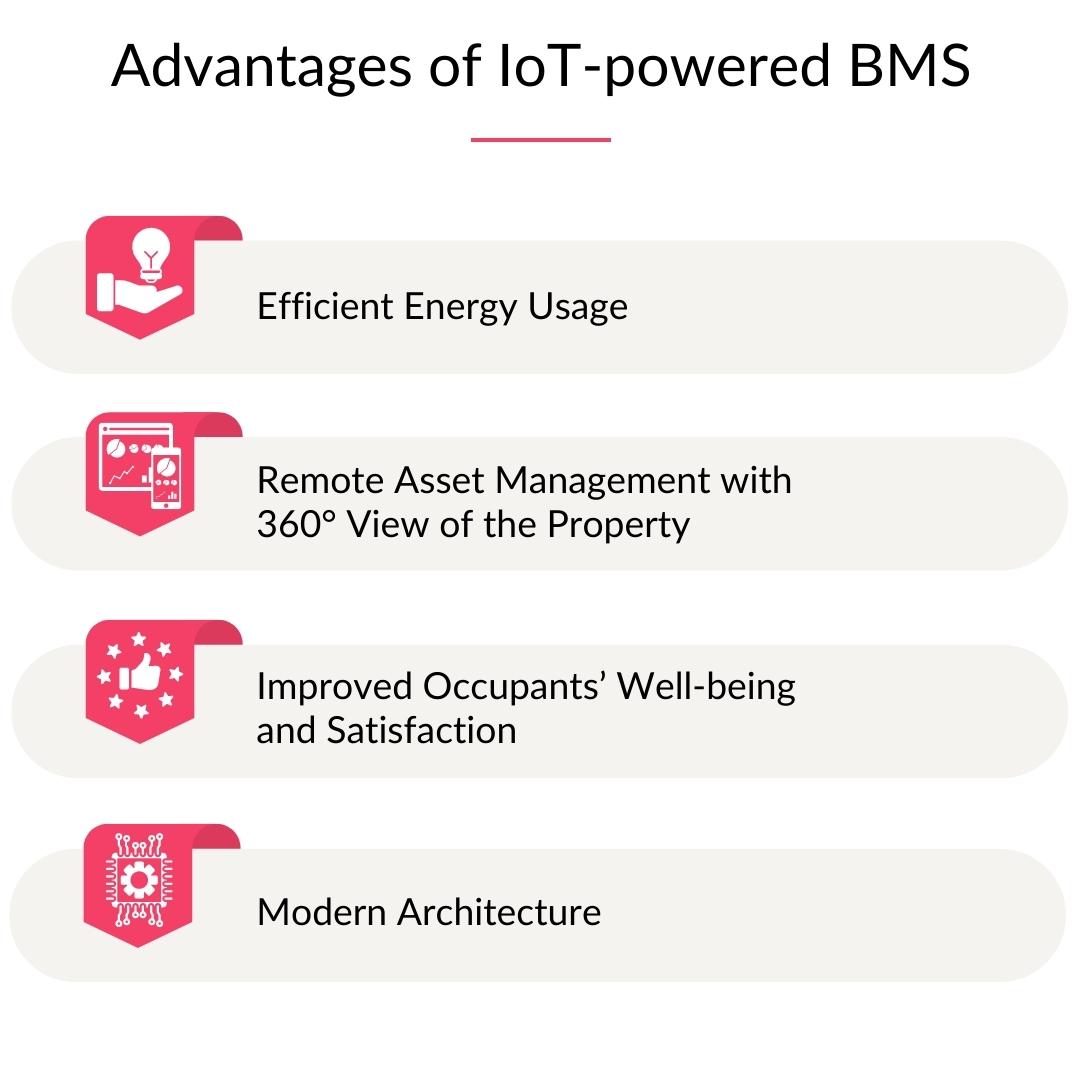Keep up with the latest IoT-based building automation, and follow us on LinkedIn!
Building Management Systems (BMS) have been used to automate equipment in large buildings for almost 3 decades, but such systems are not suitable for small & medium buildings (of less than 100K sq. ft.). This problem is compounded by the fact that customer’s multiple locations are dispersed across the geography, making it difficult to drive consistent manual behaviour, resulting in challenges such as high energy costs, compliance issues, and asset breakdown. Unfortunately, these systems still continue to operate along the same lines today. Such traditional systems are largely wired, making them difficult to deploy and maintain and requiring a significant investment. Most importantly, they lack numerous essential features such as remote asset management, scalability, energy savings, and cost-effectiveness.
Recently, there’ve been very fruitful advancements in the field of building automation. “Internet of Things” or IoT is the major one amongst these.
How can IoT transform the traditional building management system? What benefit does it bring to a traditional BMS? And more importantly, is it worth the upgrade? Let’s explore.
What is a Traditional BMS?
Simply put, a building management system controls and monitors a building’s equipment, such as HVAC systems, lighting, power systems, etc. The value BMS provides in the context of large buildings is “simplified management of numerous building equipment”. And as previously stated, this has been the case for the last decade, with little innovation in the field. As a result, there are some significant constraints. So, where does the traditional BMS fall short?
Limitations of a Traditional BMS:

1. Energy leakages – costing a lot of money
Energy leaks occur due to the following reasons:
a. Equipment Operating when not required
There have been issues with traditional BMS systems regarding the operating hours of building equipment such as chillers and lighting, and energy is wasted when equipment operates when it is not required to.
b. Poor Asset Maintenance
Prolonged usage of assets without proper maintenance results in higher energy consumption. A traditional BMS is unable to tell when an asset is not maintained properly. It only surprises when it finally breaks down, especially in a large setting.
c. Poor Power Factor
Power factor is an expression of energy efficiency. A poor power factor draws more current than a load with a high power factor for the same amount of useful power transferred. Poor power factor leads to inefficient energy consumption. Moreover, it can lead to heavy penalties on the electricity bill.
2. Lack of Centralized Visibility & Remote Asset Management
Because BMS data is confined in a control room and can’t be accessed on cloud based portal, senior management does not have centralized visibility & actionable insights.
Furthermore, having a network of equipment that generates massive amounts of data is useless unless it is analyzed and converted into actionable insights. And because of this limitation:
- A traditional BMS is unable to provide insights on predictive maintenance, i.e. fault detection & diagnosis.
- It cannot provide the necessary data points to monitor all of the equipment’s energy consumption to pinpoint the equipment responsible for inefficient energy use.
3. Suboptimal Occupant Comfort Compliances
There is certainly a lack of automation & visibility into some of the most critical aspects, especially when it comes to occupant comfort like temperature, humidity, and air quality. For instance, occupants feeling too cold or too hot as there’s no constant monitoring and controlling of the temperature levels by a traditional BMS.
4. Archaic Architecture:
A traditional BMS is connected over a wired infrastructure which makes it expensive & difficult to deploy & maintain. Furthermore, because of the outdated architecture, flexibility in terms of maintenance & upgradability along with scalability comes into question.
Commercial buildings consume roughly 40% of global energy and account for one-third of global greenhouse gas emissions. Hence, global sustainability concerns, combined with the current limitations of the traditional BMS system, necessitated the need for a cost-effective & ROI driven solution.
The incorporation of IoT technology into building management systems is one such necessity that addresses not only wastages but also a variety of other issues. With that in mind, let’s look at what IoT is and how it can overcome the limitations of traditional building management systems.
Internet of Things and what it means for the BMS sector
Internet of Things (IoT) is a network of interconnected & internet-connected objects that can collect and transfer data over a network without human intervention. When it comes to smart buildings, the interconnection of hardware and software via the internet is a significant step forward in technological advancement. IoT technology has opened up a new world of possibilities. Possibilities that have the potential to eliminate all of the aforementioned limitations of a traditional BMS.
1. Efficient Energy Usage
IoT technology complements the traditional building management system and overcomes the limitation of energy leakages. It provides building owners with insights focused on the energy usage of each equipment of the BMS. It can gather data from sensors and send control instructions to building equipment such as lighting, HVAC systems, individual machinery, etc., without manual intervention.
Above insights allow stakeholders to know the nitty-gritty of energy consumption & wastages across the portfolio of the buildings. It includes insights into various electrical parameters (Power Factor, Voltage Unbalance, Current Unbalance) & identification of suboptimal equipment.
2. Remote Asset Management with 360° View of the Property
IoT in BMS presents the opportunity for advanced data analytics. The processed data is then presented as actionable insights on a cloud based dashboard to building owners, facility managers & maintenance team. Therefore, the building can be monitored and controlled remotely & not constrained to a BMS room.
Advanced analytics of such data enables predictive maintenance of building assets and equipment. Furthermore, IoT based Building Management System has automated digital ticketing workflows for anomaly detection & FDD.
3. Improved Occupants’ Well-being and Satisfaction
Air quality, temperature, humidity, lighting, and other indoor environmental factors all play an important role in occupant comfort and well-being. An IoT based Building Management System can handle this entirely on its own. To maintain an optimal environment, it can collect data through sensors, analyze it through AI-ML-based cloud computing, and modulate the equipment responsible through actuators and relays.
4. Modern Architecture
IoT is powered by technologies like wireless mesh networks, HTTP, MQTT, ethernet, BACnet, Modbus, LoRaWAN etc. It makes IoT based BMS solutions more cost-effective than traditional wired BMS. Moreover, these are much easier to deploy, maintain, upgrade and scale.
Furthermore, because IoT based solutions are OEM agnostic, they are universally adaptable with all other building equipment. Hence, there is no need for all of the building equipment to be from the same vendor or even from the same technological era. Every piece of a BMS’s equipment can be connected using IoT based smart building management solutions. This provides universality, easy scalability and hassle-free BMS upgrades for expanded functionalities.
A traditional BMS solution cannot be relied upon to provide actionable insights for building owners. Each building is unique, and the applicability of an IoT based Building Management System for its core functionality is determined by the property’s specific needs and goals.
Request a free site survey to know how your building can be managed withZenConnect, an enterprise-grade IoT-first solution. It’s a full-stack hardware light, software intelligent, retrofit-ready, and cost-effective solution.
Keep up with the latest IoT-based building automation, and follow us on LinkedIn!

